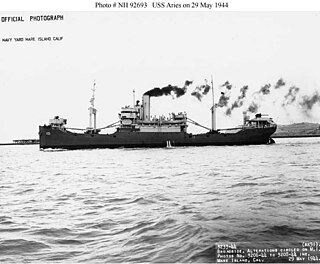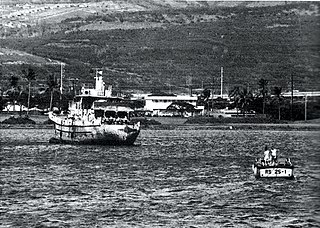
USS Abatan (AW-4) was a Pasig-class distilling ship built for the United States Navy during World War II, named after the Abatan River located in the southwestern part of Bohol Island in the Philippines.

USS Steelhead (SS-280), a Gato-class submarine, was a ship of the United States Navy named for the steelhead, a North American trout found from California to Alaska.

USS Arided (AK-73), a Crater-class cargo ship, is the only ship of the US Navy to have this name. She was named after Arided, the other name of Deneb, the alpha star of constellation Cygnus.

USS Hart (DD-594), a Fletcher-class destroyer, was the second ship of the United States Navy of that name, in honor of Lieutenant Patrick H. Hart (1912–1942), who posthumously received the Navy Cross for heroism during the Battle of Midway.

USS Aries (AK-51) (1918–1952) was a United States Navy cargo ship built as Lake Geneva under a United States Shipping Board (USSB) contract in 1918 at Duluth, Minnesota, by the McDougall Duluth Shipbuilding Company, to augment American logistics capability during World War I. The freighter was delivered to the Navy at Montreal, Quebec, Canada, on 21 September 1918 and was placed in commission the following day for service in the Naval Overseas Transportation Service. Aries was named for the constellation.
USS Chickadee (AM-59) was an Auk-class minesweeper of the United States Navy, named after the Chickadee, a family of small passerine birds which appear in North America and Africa.

The second USS Mackinac (AVP-13) was a United States Navy Barnegat-class small seaplane tender in commission from 1942 to 1947 that saw service during World War II. After the war, she was in commission in the United States Coast Guard from 1949 to 1967 as the cutter USCGC Mackinac (WAVP-371), later WHEC-371, the second ship of the Coast Guard or its predecessor, the United States Revenue Cutter Service, to bear the name.

USS Daniel A. Joy (DE-585) was a Rudderow-class destroyer escort in service with the United States Navy from 1944 to 1965. She was scrapped the following year.

USS Rochambeau (AP-63) was a transport ship that saw service in the United States Navy during World War II. She was the only U.S. Naval vessel to be named for the French nobleman, Jean-Baptiste Donatien de Vimeur, comte de Rochambeau (1725–1807), who commanded the French troops in Washington's army during the American Revolutionary War.
USS Aristaeus (ARB-1) was planned as a United States Navy LST-1-class tank landing ship, but was redesignated as one of twelve Aristaeus-class battle damage repair ships built for the United States Navy during World War II. The lead ship in her class, she was named for Aristaeus, the only US Naval vessel to bear the name.
USS Swift (AM-122) was an Auk-class minesweeper acquired by the United States Navy for the dangerous task of removing mines from minefields laid in the water to prevent ships from passing.

USS Chimaera (ARL-33) was one of 39 Achelous-class landing craft repair ships built for the United States Navy during World War II. Named for the Chimaera, she was the only U.S. Naval vessel to bear the name.

USS Flamingo (AM-32) was a Lapwing-class minesweeper built for the United States Navy near the end of World War I. After service overseas clearing mines after the Armistice, the ship was laid up until 1922 when she was transferred to the United States Department of Commerce for use by the United States Coast and Geodetic Survey. Renamed USC&GS Guide, the ship operated as a survey vessel along the West Coast of the United States for 17 years, making significant contributions to navigation, hydrographic surveying, and oceanography. In June 1941, Guide was transferred back to the Navy, converted into a salvage ship, and renamed USS Viking (ARS-1). As Viking, she worked primarily from bases in California until 1953, when she was sold for scrapping.

USS Grady (DE-445) was a John C. Butler-class destroyer escort in service with the United States Navy from 1944 to 1946 and from 1947 to 1957. She was sold for scrapping in 1969.
USS ATA-176 was an ATR-1-class rescue tug built for the United States Navy during World War II. She was laid down on 30 January 1944 and launched on 1 March as USS ATR-103, but was re-designated ATA-176 on 15 May. She was commissioned as USS ATA-176 on 19 August. She served in the U.S. Pacific Fleet during the war and was decommissioned on 30 June 1947. She was then manned with a civilian crew and placed in service, being renamed USNS Tonkawa (T-ATA-176) on 16 July 1948. Tonkawa, the first U.S. Navy vessel named for the Tonkawa, was taken out of service in 1956 and placed in reserve.
The USS Araner (IX-226) was laid down as the liberty ship Juan de Fuca under a Maritime Commission contract on 15 November 1942 at Vancouver, Washington, by the Oregon Shipbuilding Company and launched on 27 December 1942. The ship was delivered to the War Shipping Administration (WSA) on 11 January 1943 and immediately placed under a standard WSA operating agreement with Weyerhauser Steamship Company.

USS Locust (YN-17/AN-22) was an Aloe-class net laying ship built for the United States Navy during World War II. She was later transferred to the French Navy as Locuste (A765). She was sold to Malaysian owners but sank after striking a reef off Cikobia Island, Fiji, on 30 July 1978. She was towing the former French ship Scorpion, which also sank.

USS Buckeye (AN-13/YN-8) was an Aloe-class net laying ship in service with the United States Navy from 1942 to 1947. In the late 1970s and 1980s, she was used as a salvage training hulk.

USS San Carlos (AVP-51) was a Barnegat-class seaplane tender built for the United States Navy during World War II. San Carlos, named after San Carlos Bay, Florida, was in commissioned from 1944 to 1947 and earned three battle stars for service in the Pacific during World War II. After eleven years in reserve, San Carlos was converted to oceanographic research ship USNS Josiah Willard Gibbs (T-AGOR-1)—named after American scientist Josiah Willard Gibbs—and placed in service as a non-commissioned ship of the Military Sea Transportation Service from 1958 to 1971. In December 1971, the ship was transferred to the Hellenic Navy as Hephaistos (A413), a motor torpedo boat tender. Hephaistos was struck from the rolls of the Hellenic Navy in April 1976.

The first USS Algorma (AT-34) was laid down on 6 January 1919 at Port Richmond, NY, by the Staten Island Shipbuilding Co.; launched on 12 June 1919; and commissioned on 15 May 1920 at the New York Navy Yard, Brooklyn, NY.














